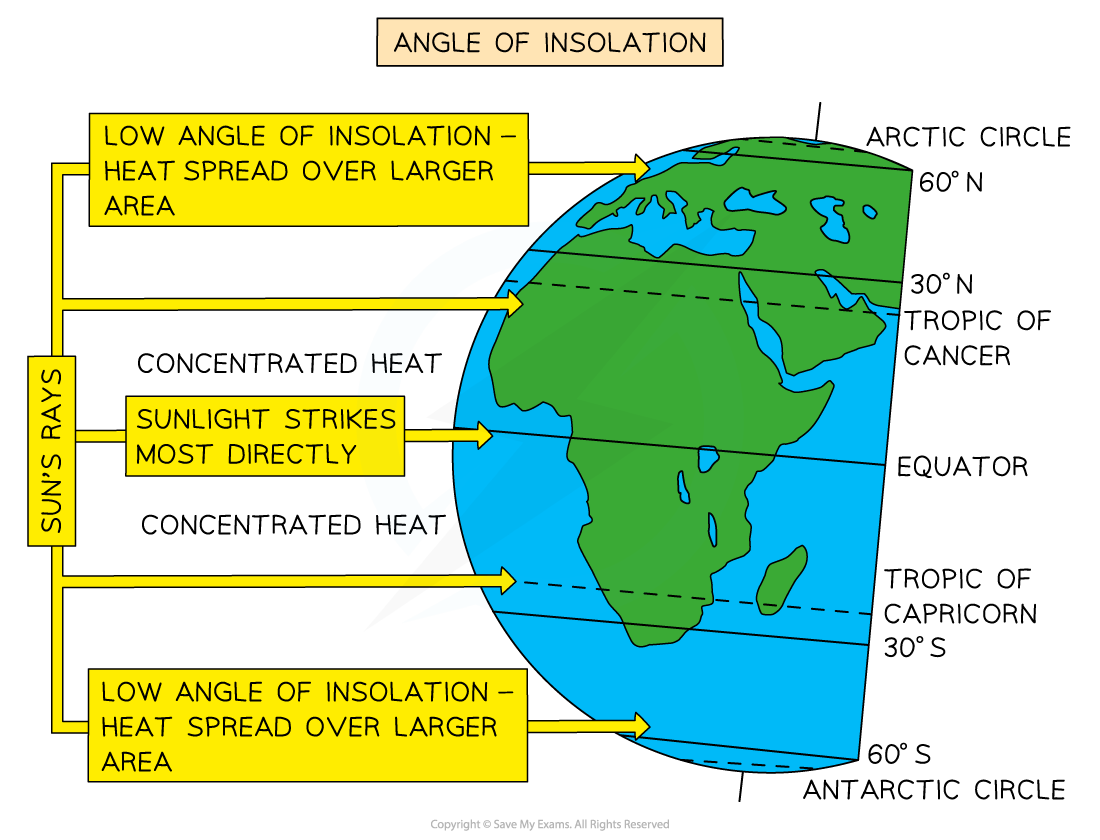Syllabus Edition
First teaching 2024
First exams 2026
Atmospheric Circulation & Ocean Currents (DP IB Environmental Systems & Societies (ESS)) : Revision Note
Tricellular Model of Atmospheric Circulation
Global atmospheric circulation
Global atmospheric circulation can be described as the worldwide system of winds that move solar heat energy from the equator to the poles to reach a balance in temperature
Wind formation
Air always moves from areas of higher pressure to lower pressure and this movement of air generates wind
Winds are large scale movements of air due to differences in air pressure
This pressure difference is because the Sun heats the Earth's surface unevenly
Insolation that reaches the Earth's surface is greater at the equator than at the poles
This is due to the Earth's curvature and the angle of the Earth's tilt

This irregular heating of the Earth’s surface creates pressure cells
In these pressure cells, hot air rises and cooler air sinks through the process of convection

Air movement within the cell is roughly circular and moves surplus heat from equatorial regions to other parts of the Earth
In both hemispheres (the Northern hemisphere and the Southern hemisphere), heat energy transfer occurs where different atmospheric circulation cells meet
There are three types of cell
Each cell generates different weather patterns
These are the Hadley, Ferrel and Polar cells
Together, these three cells make up the tricellular model of atmospheric circulation:

The tricellular atmospheric wind model
Each hemisphere has three cells (the Hadley cell, Ferrel cell and Polar cell) that circulate air from the surface, through the atmosphere, and back to the Earth's surface again
The Hadley cell is the largest cell and extends from the equator to between 30° and 40° north and south
Trade winds blow from the tropical regions to the equator and travel in an easterly direction
Near the equator, the trade winds meet, and the hot air rises and forms thunderstorms (tropical rainstorms)
From the top of these storms, air flows towards higher latitudes, where it becomes cooler and sinks over subtropical regions
This brings dry, cloudless air, which is warmed by the Sun as it descends: the climate is warm and dry (hot deserts are usually found here)
The Ferrel cell is the middle cell, and generally occurs from the edge of the Hadley cell to between 60° and 70° north and south of the equator
This is the most complicated cell as it moves in the opposite direction from the Hadley and Polar cells; similar to a cog in a machine
Air in this cell joins the sinking air of the Hadley cell and travels at low heights to mid-latitudes where it rises along the border with the cold air of the Polar cell
This occurs around the mid-latitudes and accounts for frequent unsettled weather
The Polar cell is the smallest and weakest of the atmospheric cells. It extends from the edge of the Ferrel cell to the poles at 90° north and south
Air in these cells is cold and sinks creating high pressure over the highest latitudes
The cold air flows out towards the lower latitudes at the surface, where it is slightly warmed and rises to return at altitude to the poles
Influence on terrestrial biomes
The tricellular model influences the distribution of precipitation and temperature across latitudes
Near the equator, rising warm air leads to high rainfall and high temperatures
This creates tropical rainforests and savannas
Tropical rainforests thrive in regions of high precipitation and warmth within the Hadley cell
Mid-latitudes experience variable weather due to interactions between warm and cold air masses, resulting in temperate climates with moderate precipitation
This creates temperate forests and grasslands
These biomes occur in areas within the Ferrel cell, with moderate precipitation and temperatures
High latitudes, influenced by descending cold air, have low temperatures and limited precipitation
This creates polar deserts and tundra
These biomes occur due to the cold, dry conditions within the Polar cell
These climatic factors, in turn, influence the structure and productivity of terrestrial biomes by affecting plant growth, water availability and average temperatures
The tricellular model therefore helps us to:
Understand the global distribution of biomes
Understand the ecological characteristics of biomes
Predict biome shifts due to climate change and global warming
Ocean Currents
Solar radiation absorption
Oceans act as vast heat reservoirs
This is because they absorb the solar radiation that penetrates their surface layers
Solar energy is absorbed primarily in the top layer of the ocean
Here, it warms the water and results in thermal energy being stored
Ocean currents and heat distribution
Ocean currents play an important role in distributing the heat absorbed by the oceans around the world
Surface ocean currents, driven by winds and Earth's rotation, transport warm water from the equator towards the poles and cold water from the poles towards the equator
These currents redistribute heat horizontally across the ocean surface
This movement of heat affects regional climates and weather patterns
Impact on climate and ecosystems
The redistribution of heat by ocean currents helps regulate global climate
This is because it helps to moderate temperature extremes
Warm ocean currents can bring milder, warmer weather conditions to coastal regions, while cold currents cool down coastal regions
Oceanic heat transport also affects marine ecosystems
They affect patterns of ocean productivity, distributions of marine species and levels of marine biodiversity

You've read 0 of your 5 free revision notes this week
Unlock more, it's free!
Did this page help you?

